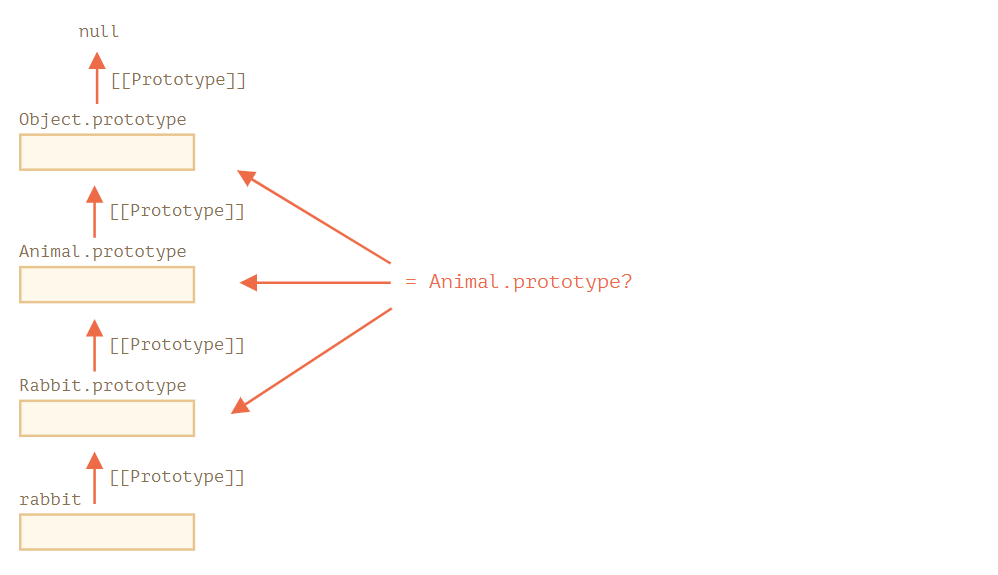 类检查:"instanceof"
类检查:"instanceof"
instanceof 操作符用于检查一个对象是否属于某个特定的 class。同时,它还考虑了继承。
在许多情况下,可能都需要进行此类检查。例如,它可以被用来构建一个 多态性(polymorphic) 的函数,该函数根据参数的类型对参数进行不同的处理。
# instanceof 操作符
语法:
obj instanceof Class
如果 obj 隶属于 Class 类(或 Class 类的衍生类),则返回 true。
例如:
class Rabbit {}
let rabbit = new Rabbit();
// rabbit 是 Rabbit class 的对象吗?
alert( rabbit instanceof Rabbit ); // true
2
3
4
5
它还可以与构造函数一起使用:
// 这里是构造函数,而不是 class
function Rabbit() {}
alert( new Rabbit() instanceof Rabbit ); // true
2
3
4
……与诸如 Array 之类的内建 class 一起使用:
let arr = [1, 2, 3];
alert( arr instanceof Array ); // true
alert( arr instanceof Object ); // true
2
3
有一点需要留意,arr 同时还隶属于 Object 类。因为从原型上来讲,Array 是继承自 Object 的。
通常,instanceof 在检查中会将原型链考虑在内。此外,我们还可以在静态方法 Symbol.hasInstance 中设置自定义逻辑。
obj instanceof Class 算法的执行过程大致如下:
如果这儿有静态方法
Symbol.hasInstance,那就直接调用这个方法:例如:
// 设置 instanceOf 检查 // 并假设具有 canEat 属性的都是 animal class Animal { static [Symbol.hasInstance](obj) { if (obj.canEat) return true; } } let obj = { canEat: true }; alert(obj instanceof Animal); // true:Animal[Symbol.hasInstance](obj) 被调用1
2
3
4
5
6
7
8
9
10
11大多数 class 没有
Symbol.hasInstance。在这种情况下,标准的逻辑是:使用obj instanceOf Class检查Class.prototype是否等于obj的原型链中的原型之一。换句话说就是,一个接一个地比较:
obj.__proto__ === Class.prototype? obj.__proto__.__proto__ === Class.prototype? obj.__proto__.__proto__.__proto__ === Class.prototype? ... // 如果任意一个的答案为 true,则返回 true // 否则,如果我们已经检查到了原型链的尾端,则返回 false1
2
3
4
5
6在上面那个例子中,
rabbit.__proto__ === Rabbit.prototype,所以立即就给出了结果。而在继承的例子中,匹配将在第二步进行:
class Animal {} class Rabbit extends Animal {} let rabbit = new Rabbit(); alert(rabbit instanceof Animal); // true // rabbit.__proto__ === Rabbit.prototype // rabbit.__proto__.__proto__ === Animal.prototype(匹配!)1
2
3
4
5
6
7
8
下图展示了 rabbit instanceof Animal 的执行过程中,Animal.prototype 是如何参与比较的:

这里还要提到一个方法 objA.isPrototypeOf(objB) (opens new window),如果 objA 处在 objB 的原型链中,则返回 true。所以,可以将 obj instanceof Class 检查改为 Class.prototype.isPrototypeOf(obj)。
这很有趣,但是 Class 的 constructor 自身是不参与检查的!检查过程只和原型链以及 Class.prototype 有关。
创建对象后,如果更改 prototype 属性,可能会导致有趣的结果。
就像这样:
function Rabbit() {}
let rabbit = new Rabbit();
// 修改了 prototype
Rabbit.prototype = {};
// ...再也不是 rabbit 了!
alert( rabbit instanceof Rabbit ); // false
2
3
4
5
6
7
8
# 福利:使用 Object.prototype.toString 方法来揭示类型
大家都知道,一个普通对象被转化为字符串时为 [object Object]:
let obj = {};
alert(obj); // [object Object]
alert(obj.toString()); // 同上
2
3
4
这是通过 toString 方法实现的。但是这儿有一个隐藏的功能,该功能可以使 toString 实际上比这更强大。我们可以将其作为 typeof 的增强版或者 instanceof 的替代方法来使用。
听起来挺不可思议?那是自然,精彩马上揭晓。
按照 规范 (opens new window) 所讲,内建的 toString 方法可以被从对象中提取出来,并在任何其他值的上下文中执行。其结果取决于该值。
- 对于 number 类型,结果是
[object Number] - 对于 boolean 类型,结果是
[object Boolean] - 对于
null:[object Null] - 对于
undefined:[object Undefined] - 对于数组:
[object Array] - ……等(可自定义)
让我们演示一下:
// 方便起见,将 toString 方法复制到一个变量中
let objectToString = Object.prototype.toString;
// 它是什么类型的?
let arr = [];
alert( objectToString.call(arr) ); // [object Array]
2
3
4
5
6
7
这里我们用到了在 装饰器模式和转发,call/apply (opens new window) 一章中讲过的 call (opens new window) 方法来在上下文 this=arr 中执行函数 objectToString。
在内部,toString 的算法会检查 this,并返回相应的结果。再举几个例子:
let s = Object.prototype.toString;
alert( s.call(123) ); // [object Number]
alert( s.call(null) ); // [object Null]
alert( s.call(alert) ); // [object Function]
2
3
4
5
# Symbol.toStringTag
可以使用特殊的对象属性 Symbol.toStringTag 自定义对象的 toString 方法的行为。
例如:
let user = {
[Symbol.toStringTag]: "User"
};
alert( {}.toString.call(user) ); // [object User]
2
3
4
5
对于大多数特定于环境的对象,都有一个这样的属性。下面是一些特定于浏览器的示例:
// 特定于环境的对象和类的 toStringTag:
alert( window[Symbol.toStringTag]); // Window
alert( XMLHttpRequest.prototype[Symbol.toStringTag] ); // XMLHttpRequest
alert( {}.toString.call(window) ); // [object Window]
alert( {}.toString.call(new XMLHttpRequest()) ); // [object XMLHttpRequest]
2
3
4
5
6
正如我们所看到的,输出结果恰好是 Symbol.toStringTag(如果存在),只不过被包裹进了 [object ...] 里。
这样一来,我们手头上就有了个“磕了药似的 typeof”,不仅能检查原始数据类型,而且适用于内建对象,更可贵的是还支持自定义。
所以,如果我们想要获取内建对象的类型,并希望把该信息以字符串的形式返回,而不只是检查类型的话,我们可以用 {}.toString.call 替代 instanceof。
# 总结
让我们总结一下我们知道的类型检查方法:

正如我们所看到的,从技术上讲,{}.toString 是一种“更高级的” typeof。
当我们使用类的层次结构(hierarchy),并想要对该类进行检查,同时还要考虑继承时,这种场景下 instanceof 操作符确实很出色。
# 实例
# 不按套路出牌的 instanceof
在下面的代码中,为什么 instanceof 会返回 true?我们可以明显看到,a 并不是通过 B() 创建的。
function A() {}
function B() {}
A.prototype = B.prototype = {};
let a = new A();
alert( a instanceof B ); // true
2
3
4
5
6
7
8
# 解决方案
是的,看起来确实很奇怪。
instanceof并不关心函数,而是关心函数的与原型链匹配的prototype。并且,这里
a.__proto__ == B.prototype,所以instanceof返回true。总之,根据
instanceof的逻辑,真正决定类型的是prototype,而不是构造函数。